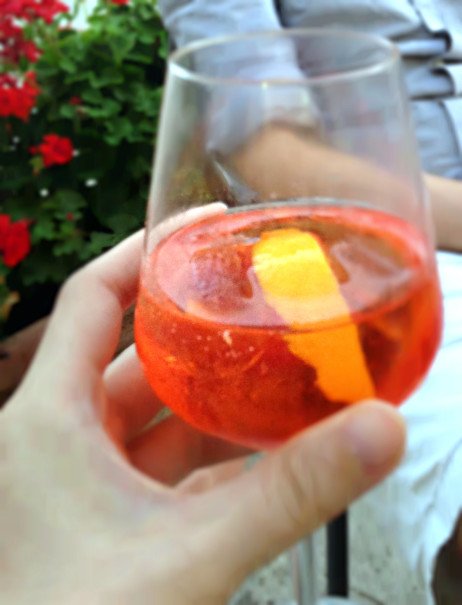
Make Mine a Mediocre Spritz

Make Mine a Mediocre Spritz
Aperol in Cetona
When my fiancé suggested we spend the summer in a small town in Italy, I was dubious. I prefer high-intensity explorations of places I know little about: driving along winding roads in rural Portugal, rushing through Beijing’s back streets, exploring a far-flung neighborhood in Paris. Summer in Tuscany, on the other hand, was a proposition I had absorbed through cultural osmosis thanks to a thousand rom-coms. However, I told myself that a more remote setting would be an interesting experiment for two city people, and that we’d be traveling frequently anyway.
We showed up in our little walled town right before sunset, and our landlord found us collapsed on his front steps after dragging our bags up the steeply angled streets. He led us to our apartment, asked us to feed the semi-feral cats he assured us would be stopping by, and pointed us in the direction of the town’s main square.
We wandered down to the piazza and found a single café open, selling lackluster gelato, espresso, and drinks. My fiancé ordered a Peroni and I ordered a spritz, which arrived along with some potato chips and overly soft green olives. It was a lovely town, but I was already planning trips to Venice and Florence, as well as pilgrimages to cheese producers and winemakers across the Italian countryside. I was determined to find the best vin santo, the grassiest olive oil, the oldest castles.
If a city’s strength is in its infinite variety, a village’s strength is in its routines. Despite my ambitions, we fell into our own patterns as the days passed: feeding the cats in the morning, afternoon visits to the vegetable woman, who was very friendly, and the pasta guy, who was not. And every evening just before sunset, a Peroni and a spritz at the café in the square. After a week or two we no longer had to order; we simply sat down and the same smiling, red-faced man who worked every evening would drop off our order with a big bowl of stale chips for my fiancé to hoover down and the insipid olives for me. Then we’d head home and feed a small herd of cats again, trying, and failing, to keep them from slipping into the apartment.
A spritz is in some ways straightforward and easily mass-produced, and is commonly made with Aperol, a bitter, orange-flavored liqueur. According to a relentless marketing campaign pursued by the Campari company, which now owns Aperol, you need simply follow the 3-2-1 formula: three parts prosecco, two parts Aperol, one splash soda. But the drink has infinite variations. The story goes that when the Habsburgs ruled Venice as part of the Austrian Empire, they balked at the strong Italian wines and added a spritzen—splash—of water to soften their drinks. From there, a thousand iterations have followed: it can be made with still white wine, with champagne, with more or less soda, garnished with an orange slice or an olive. The bitterness comes from the Aperol, or Campari, which is stronger, or, mostly in Venice, Select. In the hands of a discerning bartender, the drink can seem like a distillation of summer itself: light, slightly citrusy without being cloying, and not too boozy to have a couple on the early end of the evening.
Our café served the standard version, and our gelato-man-cum-bartender was not exactly a master mixologist. He served the drink in a large wine glass with a couple of ice cubes and an orange slice. The prosecco was too sweet, the soda lacking in effervescence, and the liqueur was not some regional amaro, but plain-old, fluorescent-orange Aperol. It was, in a word, fine.
But Italian spritz culture has more to do with meeting friends after work than the actual spirits imbibed; we walked down to the café every evening as an excuse to run into our landlord, or watch dancing in the square on Friday nights, when the entire town seemed to emerge, or to chat with the vegetable lady. I found my to-do list sitting largely ignored; our weekend plans contracted from far-flung missions to a walk down to the village fish fry.
We finally left our little town to visit Venice for a weekend later in the summer. I sat at the top of one of the city’s finest hotels, drinking a spritz while watching wooden motor boats speed past San Giorgio Maggiore. There was a bowl of flavorful olives glistening in bright, green oil, and another filled with those thick potato chips that manage to seem expensive even though they’re just potato chips. The spritz was perfectly executed: it had just the right balance of bitterness, sweetness, and effervescence. But after weeks of my daily libation, it just tasted wrong. My fiancé looked into my eyes and took my hand as the sun dipped below the canal-lined streets behind us.
“How do you think the cats are doing?” he asked.